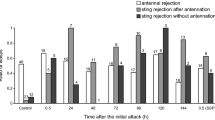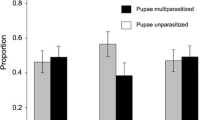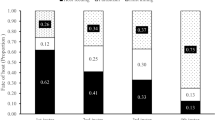Abstract
Intraspecific host discrimination and larval competition were studied forMicroplitis croceipes (Cresson),Microplitis demolitor Wilkinson,Cotesia kazak (Telenga), andHyposoter didymator (Thunberg), solitary endoparasitoids of the tobacco budworm,Heliothis virescens (F.). In ovipositional choice tests between unparasitized and parasitized hosts, the mean number of ovipositions for unparasitized hosts was significantly higher than the mean number of ovipositions for hosts parasitized once by a conspecific female forC. kazak andH. didymator, demonstrating that females of these two species discriminate against hosts recently (within a few seconds) parasitized by a conspecific female. No significant difference in oviposition occurred between these two kinds of hosts forM. croceipes andM. demolitor. Mean percent parasitization by a second conspecific female was determined at 24, 48, and 72 h delays in time between the first and second female attack, and with no delay. Except for the 0 h time delay forC. kazak andH. didymator, percent parasitization by a second conspecific female generally decreased as the delay in time between the first and second female attack increased. When the second parasitization immediately followed the first, one parasitoid larva always eliminated the other by physical combat. With a 24 or 48 h delay between the first and second parasitization, the younger larva was the victor over the older larva forM. croceipes, M. demolitor andC. kazak in at least 50% of the cases. Elimination of older larvae by younger larva was by physical attack. However, forH. didymator, the older instar was the victor, and elimination of younger larvae by older larvae was probably through physiological processes. Further, older larvae ofH. didymator apparently killed the eggs of the second female by physiological processes.
Résumé
La discrimination entre des hôtes de même espèce et la compétition larvaire ont été étudiées chezMicroplitis croceipes (Cresson),Microplitis demolitor Wilkinson,Cotesia kazak (Telenga) etHyposoter didymator (Thynberg), endoparasitoïdes solitaires deHeliothis virescens (F.). Au cours de test de choix pour l'oviposition entre des hôtes sains et parasités, le nombre moyen d'ovipositions dans des hôtes sains est significativement plus élevé que dans des hôtes parasités une fois par une femelle conspecifique chezC. kazak etH. didymator, ce qui montre que les femelles de ces deux espèces reconnaissent des hôtes récemment (quelques secondes auparavant) parasités par une femelle conspecifique. Il n'y a pas de différence significative de ponte dans ces deux types d'hôtes pourM. croceipes etM. demolitor. Le pourcentage moyen de parasitisme par une seconde femelle conspécifique a été déterminé avec un écart de 0, 24, 48 et 72 h entre l'attaque des deux femelles. Excepté pourC. kazak etH. didymator, et pour un écart nul, le pourcentage de parasitisme par la seconde femelle conspécifique diminue en général lorsque l'écart entre l'attaque des deux femelles augmente. Quand la seconde attaque suit immédiatement la première, une larve de parasitoïde élimine toujours l'autre par combat physique. Quand il y a un écart de 24 ou 48 h entre les deux attaques, la plus jeune larve est victorieuse de la plus âgée pourM. croceipes, M. demolitor etC. kazak, dans au moins la moitié des cas. L'élimination des larves les plus âgées par les plus jeunes se fait par attaque physique. Cependant chezH. didymator, c'est le stade le plus âgé qui est vainqueur et l'élimination de la larve la plus jeune se fait probablement par un processus physiologique. De plus, les larves âgées deH. didymator détruisent apparemment les œufs de la seconde femelle par des processus physiologiques.
Similar content being viewed by others
References
Alphen, J. J. M. van, Dijken, M. J. van &Waage, J. K. — 1987. A functional approach to superparasitism: Host discrimination needs not be learnt.Neth. J. Zool., 37, 167–179.
Bakker, K., Alphen, J. J. M. van, Batenburg, F. H. D. van, Hoeven, N. van der, Nell, H. W., Strien-van Liempt, W. T. F. H. van andTurlings, T. C. J. — 1985. The function of host discrimination and superparasitization in parasitoids.Oecologia, 67, 572–576.
Bosque, C. &Rabinovich, J. E. — 1979. Population dynamics ofTelenomus fariai (Hymenoptera: Scelionidae), a parasite of Chagas' disease vectors. VII. Oviposition behavior and host discrimination. —Can. Entomol., 111, 171–180.
Carl, K. P. — 1978.Heliothis armigera: parasite survey and introduction ofApanteles kazak to New Zealand. — CIBC Rep., European Stn., Delemont, Switzerland.
Chow, F. J. &Mackauer, M. — 1984. Inter- and intraspecific larval competition inAphidius smithii andPraon pequodorum (Hymenoptera: Aphidiidae).Can. Entomol., 116, 1097–1107.
Chow, J. J. &Mackauer, M. — 1986. Host discrimination and larval competition in the aphid parasiteEphedrus californicus. —Entomol. exp. appl., 41, 243–254.
Cloutier, C., Dohse, L. A. &Bauduin, F. — 1984. Host discrimination in the aphid parasitoidAphidius nigripes. —Can. J. Zool., 62, 1367–1372.
Fisher, R. C. — 1971. Aspects of the physiology of endoparasitic Hymenoptera. —Biol. Rev., 46, 243–278.
Fisher, R. C. &Ganesalingam, V. K. — 1970. Changes in the composition of host haemolymph after attack by an insect parasitoid. —Nature, 227, 191–192.
Greany, P. D. &Oatman, E. R. — 1972. Analysis of host discrimination in the parasiteOrgilus lepidus (Hymenoptera: Braconidae). —Ann. Entomol. Soc. Am., 65, 377–383.
Guillot, F. S. &Vinson, S. B. — 1972. Sources of substances which elicit a behavioral response from the insect parasitoid,Campoletis perdistinctus —Nature, 235, 169–170.
Jackson, D. J. — 1966. Observations on the biology ofCaraphractus cinctus Walker, a parasitoid of the eggs of Dytiscidae. III. The adult life and sex ratio. —Trans. Roy. Entomol. Soc. London, 118, 23–49.
Jackson, D. J. — 1969. Observations on the female reproductive organs and the poison apparatus ofCaraphractus cinctus Walker. —Zool. J. Linn. Soc., 48, 59–81.
King, E. G. &Hartley, G. G. — 1985.Heliothis virescens, pp. 323–328.In P. Singh &R. F. Moore [eds.], The handbook of insect rearing.Elsevier, Amsterdam.
King, E. G., Powell, J. E. &Coleman, R. J. — 1985. A high incidence of parasitism ofHeliothis spp. (Lep.: Noctuidae) larvae in cotton in southeastern Arkansas. —Entomophaga, 30, 419–426.
Klomp, H., Teerink, B. J. &Wei Chun Ma. — 1980. Discrimination between parasitized and unparasitized hosts in the egg parasiteTrichogramma embryophagum (Hym.: Trichogrammatidae): a matter of learning and forgetting. —Neth. J. Zool., 30, 254–277.
Lenteren, J. C. van — 1981. Host discrimination by parasitoids, pp. 153–179.In D. A. Norlund, R. L. Jones &W. J. Lewis [eds.], Semiochemicals, their role in pest control.John Wiley & Sons, New York.
Lewis, W. J. &Brazzel, J. R. — 1968. A three-year study of parasites of the bollworm and the tobacco budworm in Mississippi. —J. Econ. Entomol. 61, 673–676.
Mueller, T. F. &Phillips, J. R. — 1983. Population dynamics ofHeliothis spp. in spring weed hosts in southeastern Arkansas: Survivorship and stage-specific parasitism. —Environ. Entomol., 12, 1846–1850.
Powell, J. E. — 1989. Importation and establishment of predators and parasitoids ofHeliothis into the USA, pp. 387–395,In E. G. King andR. D. Jackson (eds.), International Workshop on Biological Control ofHeliothis: Increasing the effectiveness of natural enemies,American Press, Inc., New Delhi, India.
Powell, J. E. &Hartley, G. G. — 1987. RearingMicroplitis croceipes (Hymenoptera: Braconidae) and other parasitoids of Noctuidae with multicellular host-rearing trays. —J. Econ. Entomol., 80, 968–971.
Salt, G. — 1961. Competition among insect parasitoids. — Symp. Soc. Exp. Biol. XV, Mechanisms in Biological Competition, 15, 96–119.
SAS Institute — 1986. CMS SAS Release 5.16. SAS Institude, Inc., Cary, N.C.
Shepard, M., Lawn, R. H. &Schneider, M. A. — 1983. Insects on grain and legumes in Northern Australia. A survey of potential pests and their enemies. —Univ. of Queensland Press, Brisbane, Australia.
Strand, M. R. — 1986. The physiological interactions of parasitoids with their hosts and their influence on reproductive strategies, pp. 97–136.In J. K. Waage &D. J. Greathead [eds.], Insect parasitoids.Academic Press, New York.
Tillman, P. G. &Powell, J. E. — 1989. Comparison of acceptance of larval instars of the tobacco budworm (Lepidoptera: Noctuidae) byMicroplitis croceipes, Microplitis demolitor, Cotesia kazak (Hymenoptera: Braconidae), andHyposoter didymator (Hymenoptera: Ichneumonidae).J. Agric. Entomol., 6, 201–209.
Tillman, P. G. & Powell, J. E. — Development time in relation to temperature forMicroplitis croceipes, M. demolitor, Cotesia kazak (Hymenoptera: Braconidae), andHyposoter didymator (Hymenoptera: Ichneumonidae), endoparasitoids of the tobacco budworm (Lepidoptera: Noctuidae).Environ. Entomol., 20, 61–64.
Vinson, S. B. &Guillot, F. S. — 1972. Host-Marking: source of a substance that results in host discrimination in insect parasitoids. —Entomophaga, 17, 241–245.
Vinson, S. B. &Iwantsch, G. F. — 1980. Host suitability for insect parasitoids. —Annu. Rev. Entomol., 25, 397–419.
Wylie, H. G. — 1971. Oviposition restraint ofMuscidifurax zaraptor (Hymenoptera: Pteromalidae) on parasitized housefly pupae. —Can. Entomol. 103, 1537–1544.
Author information
Authors and Affiliations
Rights and permissions
About this article
Cite this article
Tillman, P.G., Powell, J.E. Intraspecific host discrimination and larval competition inMicroplitis croceipes, Microplitis demolitor, Cotesia kazak (HYM.: Braconidae) andHyposoter didymator HYM: Ichneumonidae), parasitoids ofHeliothis virescens (LEP.: Noctuidae). Entomophaga 37, 429–437 (1992). https://doi.org/10.1007/BF02373116
Received:
Accepted:
Issue Date:
DOI: https://doi.org/10.1007/BF02373116




